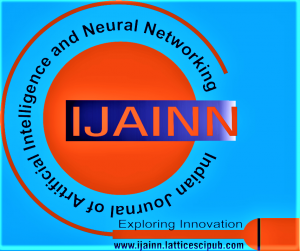![]()
EMD-CNN Based Classifier to Detect Schizophrenia from EEG Signals
Rosu Varkeyachan Padayatty1, Thasneem Fathima N.K2, Mohanraj V3
1Rosu Varkeyachan Padayatty, Assistant Professor, Department of Electrical & Electronics Engineering Ahalia School of Engineering & Technology, Palakkad (Kerala), India.
2Thasneem Fathima N.K Associate Professor, Department of Electrical & Electronics Engineering, MES College of Engineering, Kuttipuram (Kerala), India.
3Mohanraj V, Machine Learning Lead, Standard Chartered Bank, Chennai (Tamil Nadu), India.
Manuscript received on 09 February 2024 | Revised Manuscript received on 18 October 2024 | Manuscript Accepted on 15 December 2024 | Manuscript published on 30 December 2024 | PP: 1-7 | Volume-5 Issue-1, December 2024 | Retrieval Number: 100.1/ijainn.C1063043323 | DOI: 10.54105/ijainn.C1063.05011224
Open Access | Editorial and Publishing Policies | Cite | Zenodo | OJS | Indexing and Abstracting
© The Authors. Published by Lattice Science Publication (LSP). This is an open access article under the CC-BY-NC-ND license (http://creativecommons.org/licenses/by-nc-nd/4.0/)
Abstract: The United Nations has designated schizophrenia (SZ) as a serious mental illness that affects 20 million people globally. Hallucinations, delusions, and incredibly chaotic thought and behavior are some of the symptoms. SZ has an impact on a person in all facets of his life and makes it challenging to go on. Traditionally, a skilled psychiatrist uses thorough and incisive patient interviews to make the diagnosis of SZ. This procedure takes a long time and couldlead to mistakes. Therefore, the purpose of our effort is to assist physicians in making diagnoses effectively. In this work two different methods for the detection of SZ is compared and the results are analyzed. In the first method Local binary pattern which is a computationally simple andproven technique in image processing is modified and madecapable to be applied to the 1D EEG signal and histogram based features were extracted from it.Using the histogram features a feature matrix is formulated. The obtained matrix is used to train various machine learning models using the classification learner toolbox in matlab and K- nearest neighbour with medium kernel obtained a comparatively better training accuracy. Further this model is tested and an overall accuracy of 83.3 % is obtained. In the second method the EEG signals were decomposed using empirical mode decomposition (EMD). EMD is one of best signal processing technique that handle the nonlinear, nonstationary and aperiodic signal like EEG. EMD is performed to decompose the signal into various Intrinsic mode functions (IMF). Then differential entropy, a stastistical feature used to determine the randomness measure of a signal were extracted from the EEG signals. Further a feature matrix is formulated and it is trained andtested on the renowned deep learning model, the convolutional neural network. CNN performed well on theEEG data and an overall accuracy of 86 % is obtained. From the results we can see that the deep learning model (CNN) outperformed the machine learning model (K-NN) and is good and robust in detecting SZ using EEG signals.
Keywords: Electroencephalogram_(EEG), Schizophrenia (SZ), Healthy Control (HC), K-nearest Neighbor (KNN), Local Binarypattern (LBP), Intrinsic Mode Function (IMF), Empirical Mode Decomposition (EMD),1 Dimensional Convolutional Neural Network (1D-CNN).
Scope of the Article: Neural Networks
